Seonghyeon Kim
Learning to Explore for Stochastic Gradient MCMC
Aug 17, 2024Abstract:Bayesian Neural Networks(BNNs) with high-dimensional parameters pose a challenge for posterior inference due to the multi-modality of the posterior distributions. Stochastic Gradient MCMC(SGMCMC) with cyclical learning rate scheduling is a promising solution, but it requires a large number of sampling steps to explore high-dimensional multi-modal posteriors, making it computationally expensive. In this paper, we propose a meta-learning strategy to build \gls{sgmcmc} which can efficiently explore the multi-modal target distributions. Our algorithm allows the learned SGMCMC to quickly explore the high-density region of the posterior landscape. Also, we show that this exploration property is transferrable to various tasks, even for the ones unseen during a meta-training stage. Using popular image classification benchmarks and a variety of downstream tasks, we demonstrate that our method significantly improves the sampling efficiency, achieving better performance than vanilla \gls{sgmcmc} without incurring significant computational overhead.
HyperCLOVA X Technical Report
Apr 13, 2024Abstract:We introduce HyperCLOVA X, a family of large language models (LLMs) tailored to the Korean language and culture, along with competitive capabilities in English, math, and coding. HyperCLOVA X was trained on a balanced mix of Korean, English, and code data, followed by instruction-tuning with high-quality human-annotated datasets while abiding by strict safety guidelines reflecting our commitment to responsible AI. The model is evaluated across various benchmarks, including comprehensive reasoning, knowledge, commonsense, factuality, coding, math, chatting, instruction-following, and harmlessness, in both Korean and English. HyperCLOVA X exhibits strong reasoning capabilities in Korean backed by a deep understanding of the language and cultural nuances. Further analysis of the inherent bilingual nature and its extension to multilingualism highlights the model's cross-lingual proficiency and strong generalization ability to untargeted languages, including machine translation between several language pairs and cross-lingual inference tasks. We believe that HyperCLOVA X can provide helpful guidance for regions or countries in developing their sovereign LLMs.
TRACE: Table Reconstruction Aligned to Corner and Edges
May 01, 2023Abstract:A table is an object that captures structured and informative content within a document, and recognizing a table in an image is challenging due to the complexity and variety of table layouts. Many previous works typically adopt a two-stage approach; (1) Table detection(TD) localizes the table region in an image and (2) Table Structure Recognition(TSR) identifies row- and column-wise adjacency relations between the cells. The use of a two-stage approach often entails the consequences of error propagation between the modules and raises training and inference inefficiency. In this work, we analyze the natural characteristics of a table, where a table is composed of cells and each cell is made up of borders consisting of edges. We propose a novel method to reconstruct the table in a bottom-up manner. Through a simple process, the proposed method separates cell boundaries from low-level features, such as corners and edges, and localizes table positions by combining the cells. A simple design makes the model easier to train and requires less computation than previous two-stage methods. We achieve state-of-the-art performance on the ICDAR2013 table competition benchmark and Wired Table in the Wild(WTW) dataset.
Towards Unified Scene Text Spotting based on Sequence Generation
Apr 07, 2023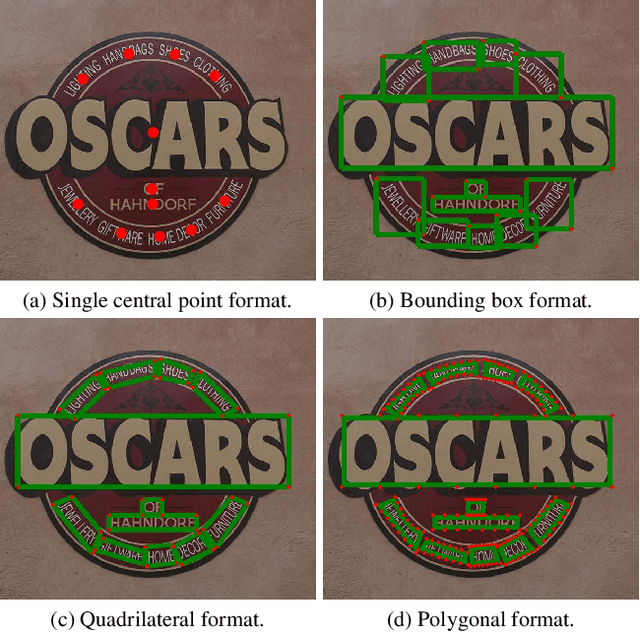
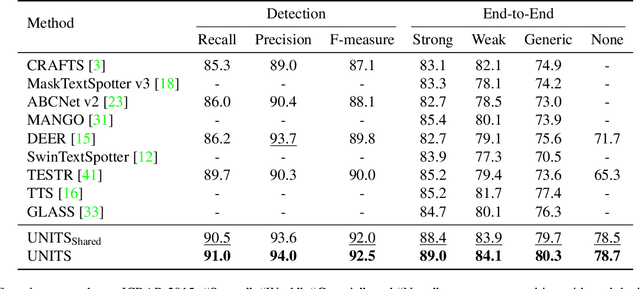
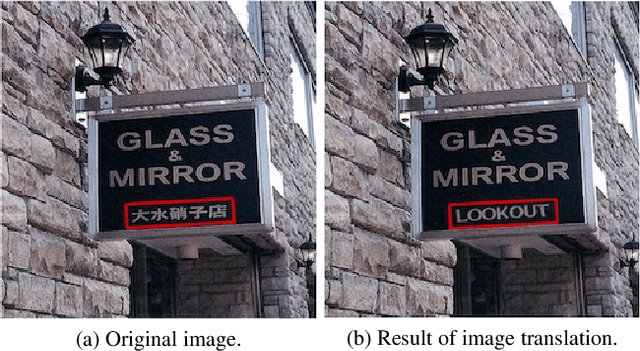
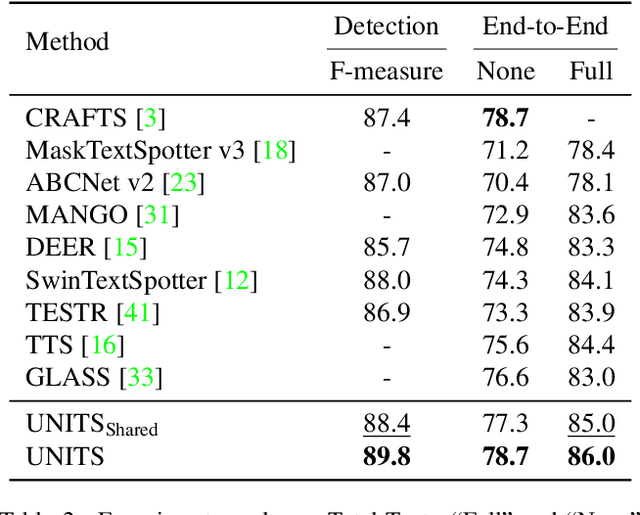
Abstract:Sequence generation models have recently made significant progress in unifying various vision tasks. Although some auto-regressive models have demonstrated promising results in end-to-end text spotting, they use specific detection formats while ignoring various text shapes and are limited in the maximum number of text instances that can be detected. To overcome these limitations, we propose a UNIfied scene Text Spotter, called UNITS. Our model unifies various detection formats, including quadrilaterals and polygons, allowing it to detect text in arbitrary shapes. Additionally, we apply starting-point prompting to enable the model to extract texts from an arbitrary starting point, thereby extracting more texts beyond the number of instances it was trained on. Experimental results demonstrate that our method achieves competitive performance compared to state-of-the-art methods. Further analysis shows that UNITS can extract a larger number of texts than it was trained on. We provide the code for our method at https://github.com/clovaai/units.
Generator Knows What Discriminator Should Learn in Unconditional GANs
Jul 27, 2022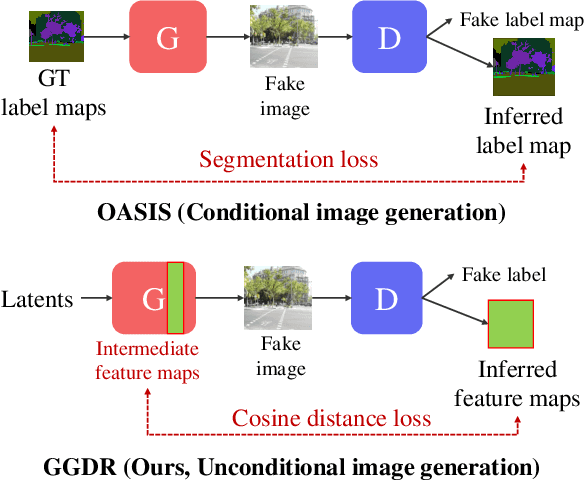
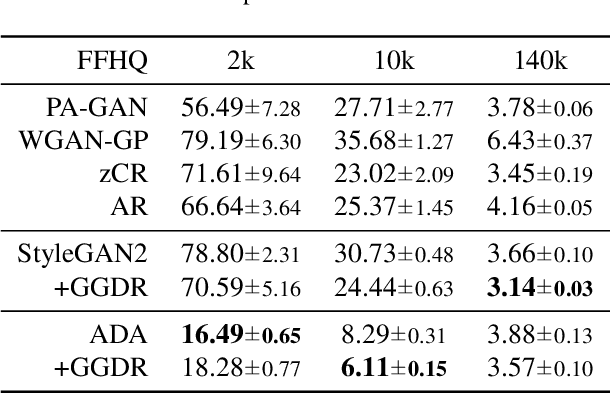
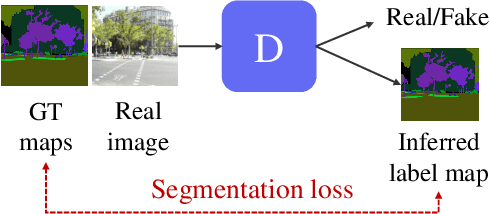
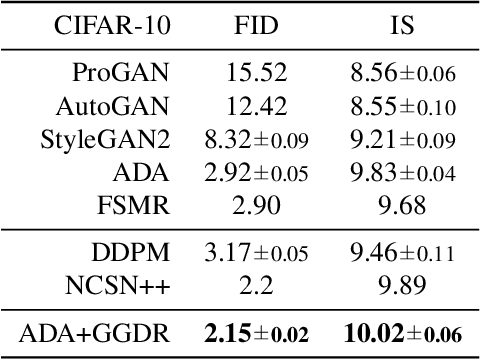
Abstract:Recent methods for conditional image generation benefit from dense supervision such as segmentation label maps to achieve high-fidelity. However, it is rarely explored to employ dense supervision for unconditional image generation. Here we explore the efficacy of dense supervision in unconditional generation and find generator feature maps can be an alternative of cost-expensive semantic label maps. From our empirical evidences, we propose a new generator-guided discriminator regularization(GGDR) in which the generator feature maps supervise the discriminator to have rich semantic representations in unconditional generation. In specific, we employ an U-Net architecture for discriminator, which is trained to predict the generator feature maps given fake images as inputs. Extensive experiments on mulitple datasets show that our GGDR consistently improves the performance of baseline methods in terms of quantitative and qualitative aspects. Code is available at https://github.com/naver-ai/GGDR
DEER: Detection-agnostic End-to-End Recognizer for Scene Text Spotting
Mar 10, 2022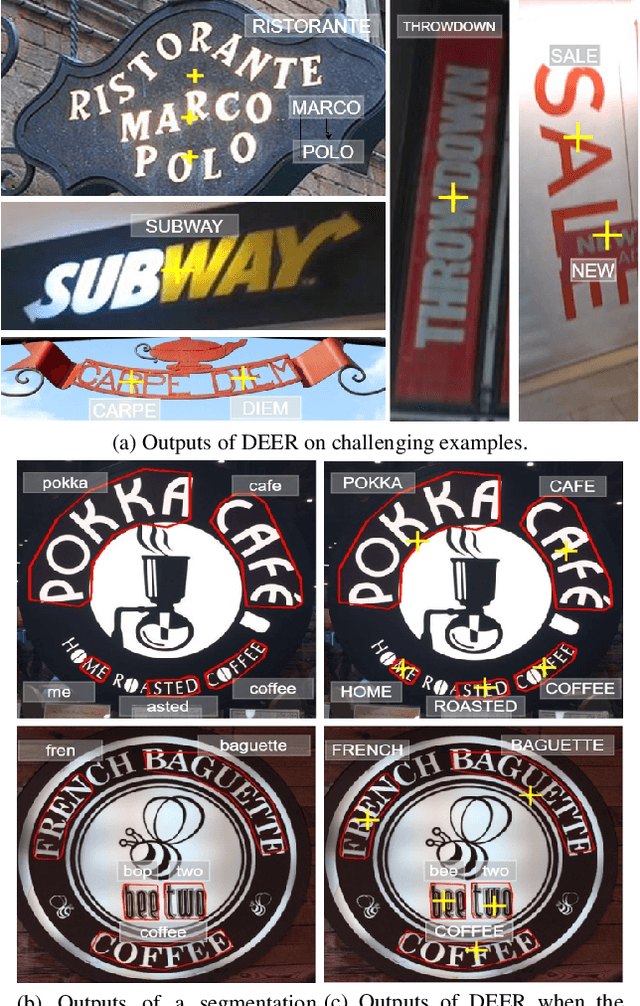
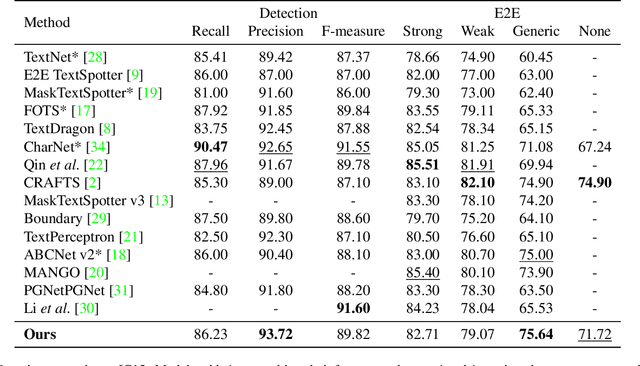
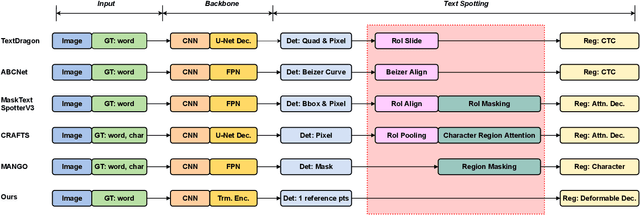
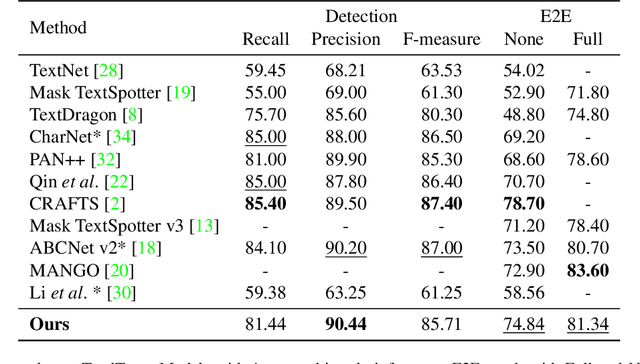
Abstract:Recent end-to-end scene text spotters have achieved great improvement in recognizing arbitrary-shaped text instances. Common approaches for text spotting use region of interest pooling or segmentation masks to restrict features to single text instances. However, this makes it hard for the recognizer to decode correct sequences when the detection is not accurate i.e. one or more characters are cropped out. Considering that it is hard to accurately decide word boundaries with only the detector, we propose a novel Detection-agnostic End-to-End Recognizer, DEER, framework. The proposed method reduces the tight dependency between detection and recognition modules by bridging them with a single reference point for each text instance, instead of using detected regions. The proposed method allows the decoder to recognize the texts that are indicated by the reference point, with features from the whole image. Since only a single point is required to recognize the text, the proposed method enables text spotting without an arbitrarily-shaped detector or bounding polygon annotations. Experimental results present that the proposed method achieves competitive results on regular and arbitrarily-shaped text spotting benchmarks. Further analysis shows that DEER is robust to the detection errors. The code and dataset will be publicly available.
RewriteNet: Realistic Scene Text Image Generation via Editing Text in Real-world Image
Jul 23, 2021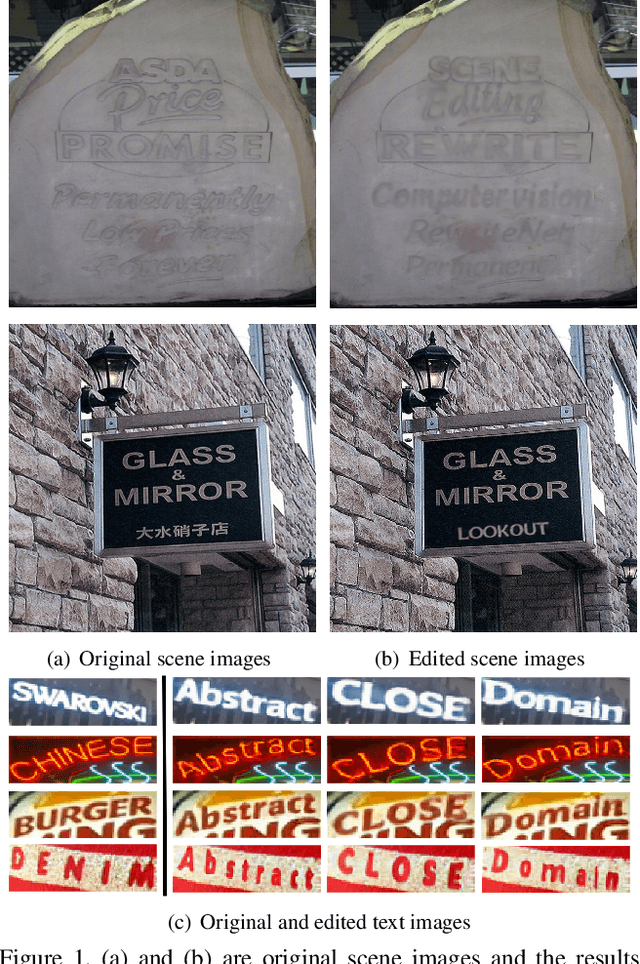
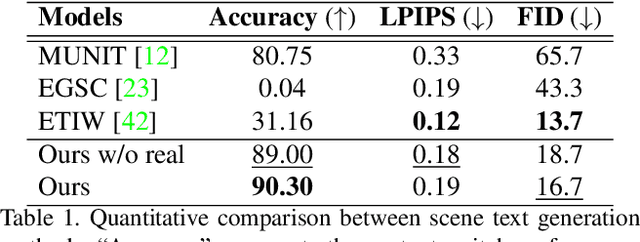
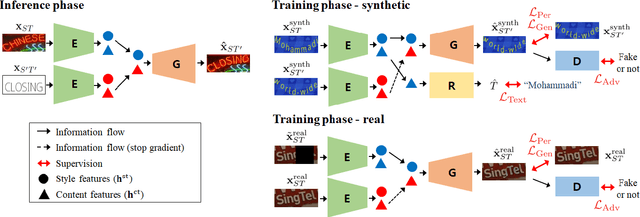
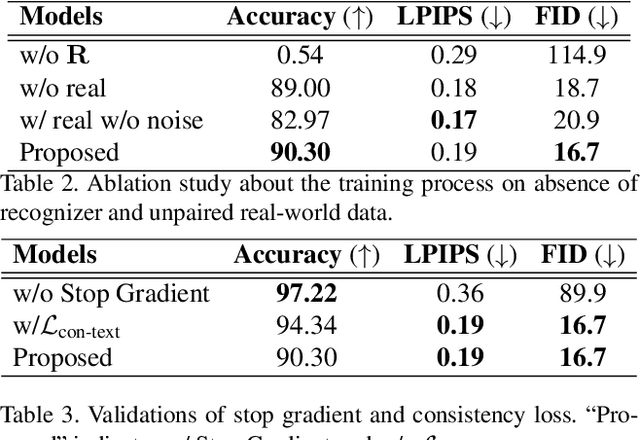
Abstract:Scene text editing (STE), which converts a text in a scene image into the desired text while preserving an original style, is a challenging task due to a complex intervention between text and style. To address this challenge, we propose a novel representational learning-based STE model, referred to as RewriteNet that employs textual information as well as visual information. We assume that the scene text image can be decomposed into content and style features where the former represents the text information and style represents scene text characteristics such as font, alignment, and background. Under this assumption, we propose a method to separately encode content and style features of the input image by introducing the scene text recognizer that is trained by text information. Then, a text-edited image is generated by combining the style feature from the original image and the content feature from the target text. Unlike previous works that are only able to use synthetic images in the training phase, we also exploit real-world images by proposing a self-supervised training scheme, which bridges the domain gap between synthetic and real data. Our experiments demonstrate that RewriteNet achieves better quantitative and qualitative performance than other comparisons. Moreover, we validate that the use of text information and the self-supervised training scheme improves text switching performance. The implementation and dataset will be publicly available.
Few-shot Compositional Font Generation with Dual Memory
May 21, 2020
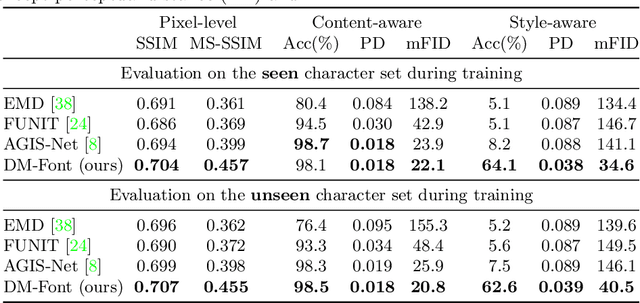

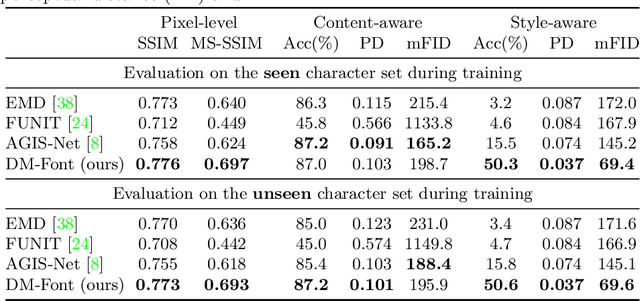
Abstract:Generating a new font library is a very labor-intensive and time-consuming job for glyph-rich scripts. Despite the remarkable success of existing font generation methods, they have significant drawbacks; they require a large number of reference images to generate a new font set, or they fail to capture detailed styles with a few samples. In this paper, we focus on compositional scripts, a widely used letter system in the world, where each glyph can be decomposed by several components. By utilizing the compositionality of compositional scripts, we propose a novel font generation framework, named Dual Memory-augmented Font Generation Network (DM-Font), which enables us to generate a high-quality font library with only a few samples. We employ memory components and global-context awareness in the generator to take advantage of the compositionality. In the experiments on Korean-handwriting fonts and Thai-printing fonts, we observe that our method generates a significantly better quality of samples with faithful stylization compared to the state-of-the-art generation methods in quantitatively and qualitatively.
On Recognizing Texts of Arbitrary Shapes with 2D Self-Attention
Oct 10, 2019



Abstract:Scene text recognition (STR) is the task of recognizing character sequences in natural scenes. While there have been great advances in STR methods, current methods still fail to recognize texts in arbitrary shapes, such as heavily curved or rotated texts, which are abundant in daily life (e.g. restaurant signs, product labels, company logos, etc). This paper introduces a novel architecture to recognizing texts of arbitrary shapes, named Self-Attention Text Recognition Network (SATRN), which is inspired by the Transformer. SATRN utilizes the self-attention mechanism to describe two-dimensional (2D) spatial dependencies of characters in a scene text image. Exploiting the full-graph propagation of self-attention, SATRN can recognize texts with arbitrary arrangements and large inter-character spacing. As a result, SATRN outperforms existing STR models by a large margin of 5.7 pp on average in "irregular text" benchmarks. We provide empirical analyses that illustrate the inner mechanisms and the extent to which the model is applicable (e.g. rotated and multi-line text). We will open-source the code.
 Add to Chrome
Add to Chrome Add to Firefox
Add to Firefox Add to Edge
Add to Edge